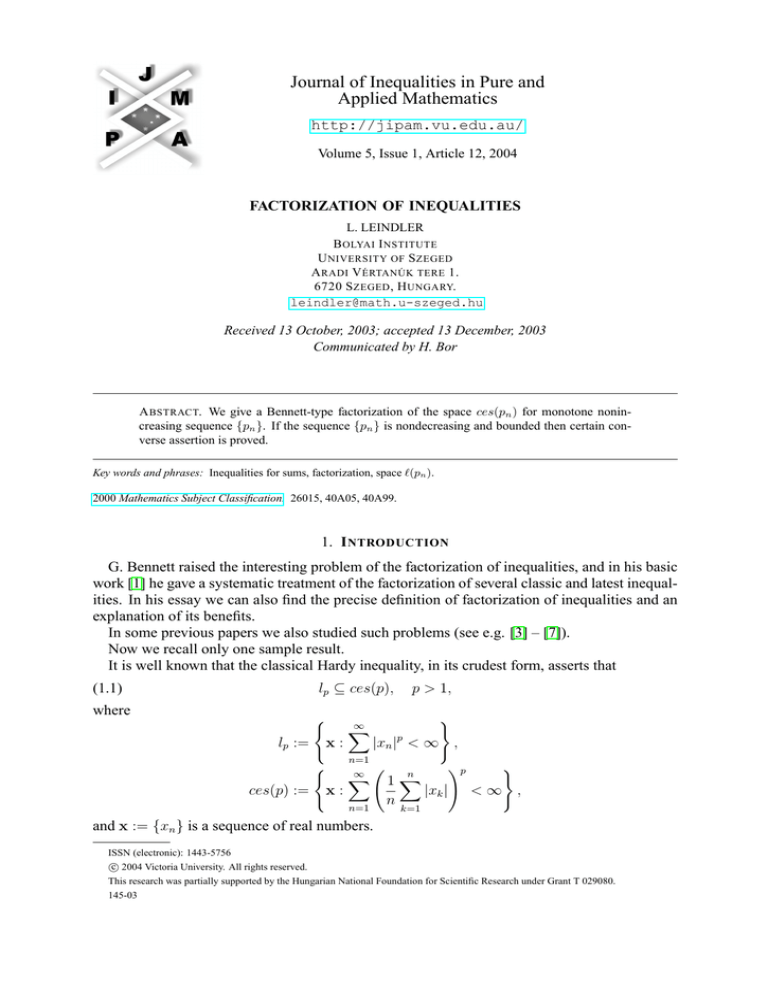
Journal of Inequalities in Pure and
Applied Mathematics
http://jipam.vu.edu.au/
Volume 5, Issue 1, Article 12, 2004
FACTORIZATION OF INEQUALITIES
L. LEINDLER
B OLYAI I NSTITUTE
U NIVERSITY OF S ZEGED
A RADI V ÉRTANÚK TERE 1.
6720 S ZEGED , H UNGARY.
leindler@math.u-szeged.hu
Received 13 October, 2003; accepted 13 December, 2003
Communicated by H. Bor
A BSTRACT. We give a Bennett-type factorization of the space ces(pn ) for monotone nonincreasing sequence {pn }. If the sequence {pn } is nondecreasing and bounded then certain converse assertion is proved.
Key words and phrases: Inequalities for sums, factorization, space `(pn ).
2000 Mathematics Subject Classification. 26015, 40A05, 40A99.
1. I NTRODUCTION
G. Bennett raised the interesting problem of the factorization of inequalities, and in his basic
work [1] he gave a systematic treatment of the factorization of several classic and latest inequalities. In his essay we can also find the precise definition of factorization of inequalities and an
explanation of its benefits.
In some previous papers we also studied such problems (see e.g. [3] – [7]).
Now we recall only one sample result.
It is well known that the classical Hardy inequality, in its crudest form, asserts that
lp ⊆ ces(p),
(1.1)
p > 1,
where
(
lp :=
x:
(
ces(p) :=
x:
∞
X
)
p
|xn | < ∞ ,
n=1
∞
X
n=1
!p
)
n
1X
|xk | < ∞ ,
n k=1
and x := {xn } is a sequence of real numbers.
ISSN (electronic): 1443-5756
c 2004 Victoria University. All rights reserved.
This research was partially supported by the Hungarian National Foundation for Scientific Research under Grant T 029080.
145-03
2
L. L EINDLER
G. Bennett [1] gave the factorization of (1.1) as follows:
Theorem 1.1. Let p > 1. A sequence x belongs to ces(p) if and only if it admits a factorization
x=y·z
(1.2)
(xn = yn · zn )
with
(1.3)
y ∈ lp
n
X
and
∗
|zk |p = O(n),
p∗ :=
k=1
p
.
p−1
This theorem may be stated succinctly as:
ces(p) = lp · g(p∗ )
if
(
g(p) :=
x:
n
X
(p > 1),
)
|xk |p = O(n) .
k=1
It is clear that Theorem 1.1 contains Hardy’s inequality, namely if x ∈ lp , then x may be
factorized as in (1.2) such that y and z satisfy (1.3) by taking y = x and z = 1 = (1, 1, . . .);
and by Theorem 1.1 then x ∈ ces(p).
In [7] we considered the problem of factorization of the set
(
!
)
∞
n
X
X
λ(ϕ) := x :
λn ϕ
|xk | < ∞ ,
n=1
k=1
where {λn } is a sequence of nonnegative terms having infinitely many positive ones, and ϕ
is a nonnegative function on [0, ∞), ϕ(0) = 0, ϕ(x)x−p is nondecreasing. If ϕ(x) = xp and
λn = n−p then, clearly λ(ϕ) ≡ ces(p). In this theme several open problems still remain.
A great number of mathematicians have investigated the following generalizations of the
spaces lp and ces(p):
)
(
∞
X
|xn |pn < ∞
l(pn ) := x :
n=1
and
(
ces(pn ) :=
x:
∞
X
n=1
!pn
)
n
1X
|xk |
<∞ ,
n k=1
where p : = {pn } is a sequence of positive numbers.
A good survey and some new results of this type can be found in the paper [2] by P.D. Johnson
and R.N. Mohapatra.
The aim of the present paper is to find certain factorization of the space ces(pn ). Unfortunately we can do this only if the sequence p := {pn } is monotone decreasing. In the case if
p is monotone increasing we can give sufficient conditions for the sequences y and z such that
their product sequence x = y · z should belong to ces(pn ). Hence it is clear that if pn = p for
all n, then we get a necessary and sufficient condition as in Theorem 1.1.
Naturally many similar problems can be raised (and solved if you have enough stoicism and
calculation ability) if you want to give the analogies of the results given in the special case
pn = p regarding all the factorizations of inequalities (see e.g. only [1], [6] and [7]).
To present our theorem easily we need one more definition:
(
)
n
X
g(pn ) := x :
|xk |pk ≤ K pn −1 n ,
k=1
J. Inequal. Pure and Appl. Math., 5(1) Art. 12, 2004
http://jipam.vu.edu.au/
FACTORIZATION OF I NEQUALITIES
3
where K = K( p) ≥ 1 is a constant depending only on the sequence p.
2. T HE R ESULTS
Our theorem reads as follows:
Theorem 2.1.
(i) If p := {pn } is a nonincreasing sequence of numbers, all pn > 1; and
x ∈ ces(pn ), then x admits a factorization (1.2) with
z ∈ g(p∗n ).
y ∈ l(pn ) and
(2.1)
(ii) Conversely, if p is a nondecreasing and bounded sequence of numbers, p0 > 1, furthermore (2.1) holds, then the product sequence x = y · z ∈ ces(pn ).
Part (ii) of our theorem clearly implies that
l(pn ) ⊆ ces(pn )
(1 < p0 ≤ . . . ≤ pn ),
since if x ∈ l(pn ) then x can be factorized as in (1.2) with (2.1) by taking y = x and z = 1 =
(1, 1, . . .), and thus we get that x ∈ ces(pn ).
In order to prove our theorem we require the following lemma.
Lemma 2.2. Let u, v, w be sequences with nonnegative terms and suppose that wk decreases
with k. If
n
n
X
X
uk ≤
vk (n = 1, 2, . . .),
k=1
k=1
then
n
X
uk wk ≤
n
X
vk wk
(n = 1, 2, . . .).
k=1
k=1
This result is well known, see e.g. Lemma 3.6 in [1].
3. P ROOF OF T HEOREM 2.1
(i) We assume that x 6= 0 := (0, 0, . . .), otherwise the statement is trivial.
If x ∈ ces(pn ), we set
!pk −1
∞
k
X
X
−pk
(3.1)
bn :=
|xi |
,
k
k=n
(3.2)
i=1
and we note that bn monotonically tends to zero. Indeed, using the well-known inequality
∗
ap b p
ab ≤
+ ∗ , p > 1,
p
p
we have that
!pk −1
∞
k
X
1 1X
bn =
|xi |
k
k
i=1
k=n
!pk
∞
∞
k
X 1
X
1 1X
≤
+
|xi |
,
pk k pk k=n p∗k k i=1
k=n
J. Inequal. Pure and Appl. Math., 5(1) Art. 12, 2004
http://jipam.vu.edu.au/
4
L. L EINDLER
where the second sum clearly tendsPto zero because x ∈ ces(pn ) and pk > 1. The first
sums also tends to zero, namely if ∞
i=1 |xi | ≤ 1, then, by pk ≤ p0 , the inequality
!
!p0
pk
∞
k
∞
k
X
X
1X
1 X
|xi |
≥
|xi |
pk
k
k
i=1
i=1
k=1
k=1
and x 6= 0 imply this assertion.
Now we factorize x as follows
x = y · z (xn = yn zn ),
where
yn := (|xn |bn )1/pn sign(xn )
(3.3)
and
∗
n
zn := |xn |1/pn b−1/p
(≥ 0).
n
(3.4)
Thus, by (3.1) and (3.3), we have
∞
X
pn
|yn |
=
n=1
∞
X
|xn |
∞
X
n=1
=
=
∞
X
k
k
k
X
k=1
i=1
∞
X
k
X
k −pk
!pk −1
|xi |
i=1
!pk −1
k=n
−pk
k
X
−pk
|xi |
k
X
|xn |
n=1
!pk
|xi |
,
i=1
k=1
thus the condition x ∈ ces(pn ) implies y ∈ l(pn ).
On the other hand, by Hölder’s inequality,
!pm
!pm
m
m
X
X
∗
∗
1
1
−p /p
p
+
zk k
=
|xk | p∗m pm bk k k
k=1
k=1
m
X
≤
(3.5)
k=1
(3.6)
! pm
∗
pm
|xk |
m
X
−
|xk |bk
pm p ∗
k
pk
!
.
k=1
Consequently, for m = 1, 2, . . ., we have by (3.1), (3.4) and (3.5),
!pm
!pm −1 m
∞
m
∞
m
pm p ∗
X
X
X
X
X
∗
− p k
1
pk
−pm
zk
≤
n
|xk |
|xk |bk k
n
n=m
n=m
k=1
k=1
k=1
!pm −1
∗
∞
m
m
pm p
X
X
− p k X
=
|xk |bk k
n−pm
|xk |
.
n=m
k=1
k=1
Since x ∈ ces(pn ) implies that
n
1X
|xk | ≤ K1 (p)
n k=1
J. Inequal. Pure and Appl. Math., 5(1) Art. 12, 2004
http://jipam.vu.edu.au/
FACTORIZATION OF I NEQUALITIES
5
holds for all n; where and later on Ki (p) is written instead of Ki ( p), thus, by (3.2),
!pm −1
∞
m
X
X
|xk |
n−pm
n=m
k=1
=
∞
X
m
X
n−pm
n=m
npn −pm
|xk |
k=1
∞
X
≤ K2 (p)
(3.7)
!pn −1
m
X
!pm −pn
|xk |
k=1
n−pn
n
X
n=m
!pn −1
|xk |
= K2 (p)bm .
k=1
By (3.2) we also have that the sequence {bk } is bounded, whence
pk −pm
pk −1
≤ K3 (p)
bk
also hold for any k and m ≥ k. Hence we get that
m
X
−
|xk |bk
pm p ∗
k
pk
≡
k=1
m
X
p∗
− pk
|xk |bk
k
b
pk −pm
−1
pk −1
k=1
≤
(3.8)
K3 (p)b−1
m
m
X
p∗
zk k .
k=1
Collecting the estimations (3.6), (3.7) and (3.8) we have that
!pm −1
∞
m
X
X
∗
p
n−pm
zk k
≤ K4 (p).
n=m
k=1
Hence an easy computation gives that
m
X
p∗
1
∗
zk k ≤ K(p) pm −1 m = K(p)pm −1 m;
k=1
and herewith we have proved that z ∈ g(p∗n ).
This completes the proof of part (i).
(ii) The assumption z ∈ g(p∗n ) yields that
n
X
p∗k
|zk |
≤ K(p)
n
X
1
pn −1
k=1
1.
k=1
This and Lemma 2.2 with wk := k −1/2 imply
n
X
(3.9)
p∗k −1/2
|zk | k
≤ K(p)
1
pn −1
k=1
n
X
k −1/2 .
k=1
On the other hand, if x = y · z, applying Hölder’s inequality, we have
!pn
!pn
n
n
X
X
∗
∗
|xk |
=
|yk |k 1/2pn k −1/2pn |zk |
k=1
k=1
≤
n
X
k=1
J. Inequal. Pure and Appl. Math., 5(1) Art. 12, 2004
!
|yk |pn k
pn −1
2
n
X
!pn −1
p∗n
k −1/2 |zk |
.
k=1
http://jipam.vu.edu.au/
6
L. L EINDLER
This and (3.9) exhibit that
!pn
∞
n
∞
n
X
X
X
pn −1
pn −1
1X
|xk |
(3.10)
≤ K5 (p)
n−pn
|yk |pn k 2 n 2
n k=1
n=1
n=1
k=1
∞
∞ pn2−1
X
X
k
1
|yk |pn
=: S1 , say.
= K5 (p)
n
n
k=1
n=k
Since y ∈ l(pn ), the terms yn are bounded, using this, furthermore the boundedness
and the monotonicity of the sequence p, we know that
∞
∞ pk2−1
X
X
k
1
pk
S1 ≤ K6 (p)
|yk |
n
n
k=1
n=k
≤ K6 (p)
∞
X
|yk |pk k
(3.11)
≤ K7 (p)
∞
X
1
n−1− 2 (pk −1)
n=k
k=1
∞
X
pk −1
2
|yk |pk .
k=1
The assumption y ∈ l(pn ), (3.10) and (3.11) plainly prove that x ∈ ces(pn ), as
stated.
Herewith we have completed the proof of the theorem.
R EFERENCES
[1] G. BENNETT, Factorizing the Classical Inequalities, Memoirs of Amer. Math. Soc., 120 (1996)
No 576, 1–130.
[2] P.D. JOHNSON JR. AND R.N. MOHAPATRA, On an analogue of Hardy’s inequality, Arch. Math.,
60 (1993), 157–163.
[3] L. LEINDLER, A theorem of Hardy–Bennett-type, Acta Math. Hungar., 78 (1998), 315–325.
[4] L. LEINDLER, Two theorems of Hardy–Bennett-type, Acta Math. Hungar., 78 (1998), 365–375.
[5] L. LEINDLER, Hardy–Bennett-type theorems, Math. Ineq. and Applications, 1 (1998), 517–526.
[6] L. LEINDLER, Two Hardy–Bennett-type theorems, Acta Math. Hungar., 85 (1999), 265–276.
[7] L. LEINDLER, An addition to factorization of inequalities, Math. Pannonica, 10 (1999), 61–65.
J. Inequal. Pure and Appl. Math., 5(1) Art. 12, 2004
http://jipam.vu.edu.au/







